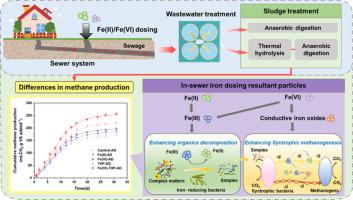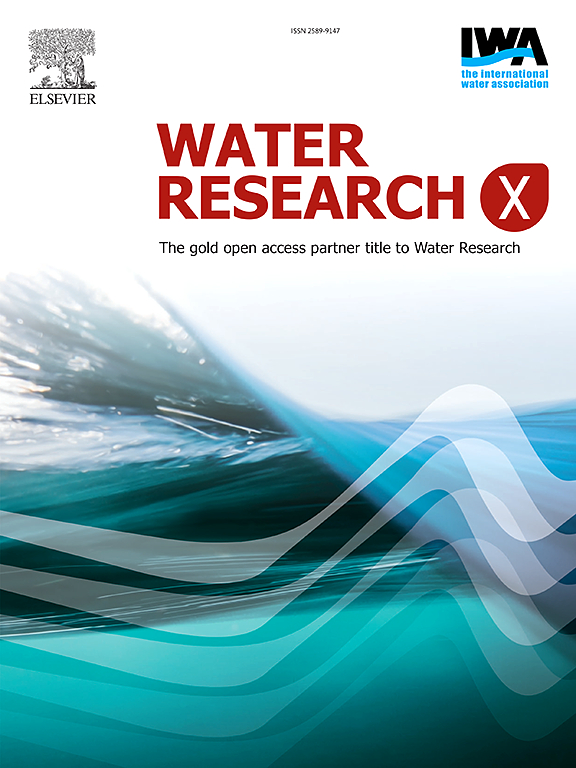In-sewer iron dosing enhances bioenergy recovery in downstream sewage sludge anaerobic digestion: The impact of iron salt types and thermal hydrolysis pretreatment
IF 7.2
2区 环境科学与生态学
Q1 ENGINEERING, ENVIRONMENTAL
引用次数: 0
Abstract
Dosing iron salts is a widely adopted strategy for sewer odor and corrosion management, and it can affect bioenergy recovery during anaerobic digestion (AD) of sludge in downstream wastewater treatment plants. However, the different impacts of in-sewer iron salt dosing on AD, depending on the types of iron and digestion conditions, remain unclear. Therefore, this study investigated the impact of in-sewer ferrous (Fe(II)) and ferrate (Fe(VI)) dosing on bioenergy recovery in both conventional AD and AD with thermal hydrolysis pretreatment (THP). The results showed that in-sewer Fe(VI) dosing notably enhanced methane production in AD more than in-sewer Fe(II) dosing, with cumulative methane yields of 197.1±1.9 mLCH4∙gVSadded−1 for Fe(VI) and 186.5±10.4 mLCH4∙gVSadded−1 for Fe(II), respectively. Microbial analyses and iron particle characterizations suggested that the superior promotion with Fe(VI) dosing may be attributed to the smaller particle sizes and higher iron oxide content of Fe(VI) resultant products. This led to a greater enhancement in direct interspecies electron transfer (DIET) between syntrophic bacteria and methanogens, as indicated by the upregulation of Methanosaeta and key functional genes involved in CO2-utilizing methanogenesis. Additionally, in THP-AD, the methane production enhancement caused by in-sewer iron dosing (35.5 mLCH4∙gVSadded−1) exceeded that in conventional AD (26.9 mLCH4∙gVSadded−1), although organic degradation during THP was unaffected. As THP-AD gains popularity for improved bioenergy recovery from sludge, our findings suggest that in-sewer iron dosing supports this advancement. Furthermore, in-sewer Fe(VI) dosing appears more promising within integrated wastewater management strategies, facilitating energy- and carbon-neutralization of urban water systems.

污水管内加铁可提高下游污水污泥厌氧消化的生物能回收率:铁盐类型和热水解预处理的影响
投加铁盐是下水道臭味和腐蚀管理中广泛采用的一种策略,而且会影响下游污水处理厂污泥厌氧消化(AD)过程中的生物能回收。然而,根据铁的类型和消化条件的不同,下水道内投加铁盐对厌氧消化的不同影响仍不清楚。因此,本研究调查了污水中加入亚铁(Fe(II))和铁酸盐(Fe(VI))对传统厌氧消化(AD)和热水解预处理(THP)厌氧消化(AD)中生物能源回收的影响。结果表明,污水中添加铁(VI)比添加铁(II)更显著地提高了厌氧消化(AD)中的甲烷产量,铁(VI)和铁(II)的累计甲烷产量分别为 197.1±1.9 mLCH4∙gVSadded-1 和 186.5±10.4 mLCH4∙gVSadded-1。微生物分析和铁颗粒特征表明,加入 Fe(VI)后,促进作用更强,这可能是由于加入 Fe(VI)后的产物颗粒更小,氧化铁含量更高。这导致合成细菌和甲烷菌之间的直接种间电子传递(DIET)得到了更大的增强,Methanosaeta 和参与二氧化碳利用甲烷生成的关键功能基因的上调表明了这一点。此外,在 THP-AD 中,尽管 THP 过程中的有机物降解未受影响,但污水中加入铁元素(35.5 mLCH4∙gVSadded-1 )可提高甲烷产量,超过传统 AD(26.9 mLCH4∙gVSadded-1 )。随着 THP-AD 在提高污泥生物能回收率方面的普及,我们的研究结果表明,污水中铁的投加有助于这一进步。此外,在废水综合管理战略中,污水中添加铁(VI)似乎更有前景,可促进城市水系统的能源和碳中和。
本文章由计算机程序翻译,如有差异,请以英文原文为准。
求助全文
约1分钟内获得全文
求助全文
来源期刊

Water Research X
Environmental Science-Water Science and Technology
CiteScore
12.30
自引率
1.30%
发文量
19
期刊介绍:
Water Research X is a sister journal of Water Research, which follows a Gold Open Access model. It focuses on publishing concise, letter-style research papers, visionary perspectives and editorials, as well as mini-reviews on emerging topics. The Journal invites contributions from researchers worldwide on various aspects of the science and technology related to the human impact on the water cycle, water quality, and its global management.
 求助内容:
求助内容: 应助结果提醒方式:
应助结果提醒方式:


